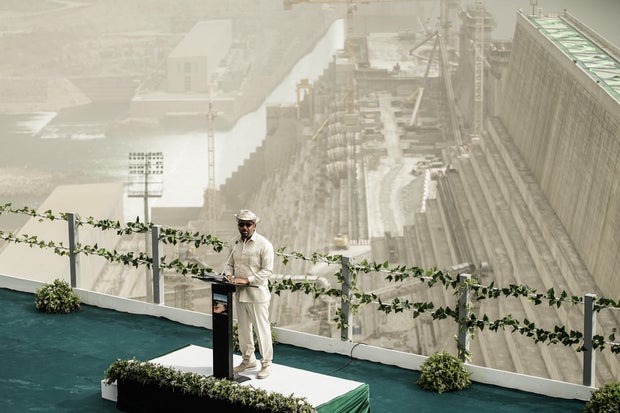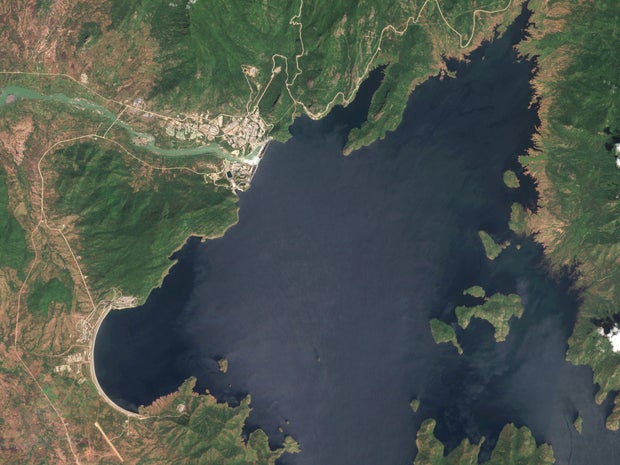
Ethiopia to open GERD mega-dam despite warnings from Sudan and Egypt over Nile water supplies
Johannesburg — Africa’s largest hydroelectric dam, the Grand Ethiopian Renaissance Dam (GERD), on the Blue Nile is scheduled to open Tuesday to major fanfare in Ethiopia. The $5 billion dam project has been a uniting force for Ethiopians both at home and abroad, who have helped to fund the project.
Funding calls had gone out since the project was launched in 2011, with the government also issuing bonds to fund construction of the mile-long, 475-foot-high structure.
The celebrations in Ethiopia, however, will not extend further down the mighty river into neighboring Sudan or Egypt, both of which have warned that the dam could bring grave consequences.
After years of failed talks, there was still no agreement in place a day before the dam was due to commence operations on how the water will flow through the mammoth structure to ensure adequate supplies in Egypt and Sudan.
AMANUEL SILESHI/AFP/Getty
Only 54% of Ethiopia’s roughly 120 million inhabitants have access to reliable power, and Ethiopian officials have said the 5,150-megawatt capacity dam is expected to double national electricity generation capacity.
Egypt and Sudan’s opposition to the dam
In a joint statement last week, Egypt and Sudan said the dam “breached international law and would cause grave consequences to the two downstream countries.”
Both nations have said they now consider water security a national security concern.
The Blue Nile flows from Ethiopia to Khartoum, Sudan’s capital, where it joins the White Nile before flowing into Egypt as the Nile.
Getty/iStockphoto
The Blue Nile, soon to flow through the new dam, supplies more than 80% of the water for the combined river system.
Egypt’s government, noting that more than 90% of the country is desert, has said most of its population lives along the Nile, and it has raised concern for years that the dam will reduce water flow and cause shortages — and officials have warned they will take measures in response if that happens.
“Anyone who imagines that Egypt will turn a blind eye to an existential threat to its water security is mistaken,” Egyptian leader Abdel Fattah El-Sisi said in August, calling it a potential “existential” threat to his country.
“We will continue to monitor the situation and take all measures provided for under international law to safeguard our people’s existential resources,” El-Sisi said.
Ethiopian Prime Minister Abiy Ahmed has been widely quoted as saying the dam will benefit everyone in the region, through power purchase agreements and flood control.
AMANUEL SILESHI/AFP via Getty
“To our neighbours downstream — Egypt and Sudan — our message is clear: The Renaissance Dam is not a threat, but a shared opportunity. It is a symbol of regional cooperation and mutual benefit. The energy and development it will generate stand to uplift not just Ethiopia, but the entire region,” he said in remarks on July 3.
In a social media post on Sept. 2, Abiy called seeing the dam completed “a historic milestone in Ethiopia,” adding that for him personally it was a “final prayer and it was my ultimate wish.”
Trump’s criticism and the U.S. stance on GERD
The U.S. government has long tried to balance the concerns and needs of the countries in the region when it comes to the dam project. During the Biden administration in 2024, then Assistant Secretary of State Molly Phee told reporters the U.S. had “underscored our recognition of” Egypt’s water needs “and the importance of the Nile to Egypt,” along with “Sudan’s concerns about dam operations and safety, and Ethiopia’s compelling development needs.”
She said the U.S. was “committed to helping all these parties discuss how agreements related to water management, use, and access can contribute to security and stability” in the region, and she said the administration remained “ready to engage diplomatically in support of such efforts.”
More recently, President Trump has criticized the dam, claiming several times without offering evidence or clarification, most recently in late July — that the project was “stupidly” funded “with United States money, largely,” and noting specifically Egypt’s concerns over its Nile water supply.
Gallo Images/Orbital Horizon/Copernicus Sentinel Data
The coordination body established by Ethiopia’s government to drum up funding for the project has vehemently denied Mr. Trump’s assertions, insisting the dam was built “without any foreign aid.”
Ethiopia will be hosting the Second Africa Climate Summit from Monday, and Abiy has voiced hope that African leaders attending the summit will also attend Tuesday’s GERD grand opening celebrations.
The dam is expected to bring in $1 billion in revenue annually, according to Abiy, who has pledged that the money will help finance other infrastructure projects.







